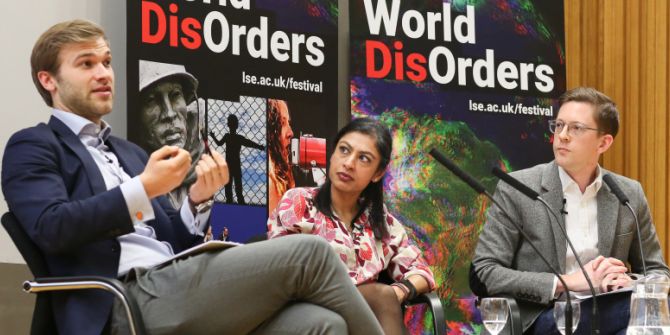Beijing policy towards the Uyghur ethnic group has changed from encouraging gradual economic and cultural assimilation – supported by forceful measures – to a more immediate and indiscriminate use of physical and ideological force, writes Roderic Wye, following international reports of vast numbers of Uyghurs being sent to detention camps. This is the starkest example of the widespread intensification of religious persecution across China, with the central government wary of any ideological challenge to its authority. Particular suspicion is cast upon the influential ‘foreign’ religions of Islam and Christianity.

The Chinese state is engaged in an unprecedented exercise in forced social engineering directed at the Muslim population in Xinjiang. The official pretext is the need to eliminate all forms of separatism, terrorism and religious fundamentalism in the region. The reality is that possibly as many as one million Uyghurs (the largest Muslim ethnic group in the region, but others are affected as well) have been sent to internment/detention camps without any sound legal basis and at least as many more compelled to take evening re-education classes. This should be considered in the context of a Uyghur population of approximately 11 million.
Situated in the far West of China bordering on Central Asia, Xinjiang and its Uyghur population have long had a problematic relationship with the central authorities. Until recently, the Chinese approach has basically been one of economic assimilation, hoping that economic development (combined of course with the judicious use of education and social and political pressure) will eventually lead the ethnic minorities in Xinjiang, and indeed elsewhere in China, to assimilate fully, or at the very least to no longer pose any form of social challenge because of their difference. Official apologists for Chinese behaviour still base their arguments on the economic prosperity that the central government has delivered, and the numbers of people lifted out of poverty. Detainees are viewed by the state as being in need of treatment for ideological illness.
This approach has changed dramatically in the past two years, possibly coinciding with the appointment of Chen Quanguo (previously the central authorities’ man in Tibet) to the leadership in Xinjiang. But he is more likely to be the chosen instrument rather than the initiator of the new policy. A number of high profile event such as the riots in Urumqi in 2009 and some mass terrorist incidents involving Uyghurs in China proper, as well as ongoing problems in Xinjiang itself, may have contributed to this change of heart. In addition, Xinjiang has if anything assumed greater strategic and economic significance as it is a gateway for China’s Belt and Road Initiative to which the current leadership attaches the highest importance. The leadership can no longer tolerate anything that might appear to upset the smooth workings of the state in the region.
What is happening in Xinjiang is as clear a manifestation of extremist behaviour by the authorities as the extremism they purport to condemn. There were undoubtedly instances of dissent and resistance in Xinjiang, even violent ones, over the years which any state could reasonably claim the right to control. But now the entire Uyghur population is seemingly being treated as suspect and in need of re-education, or brainwashing to use an old-fashioned term. Systematic efforts are being made to constrict and even obliterate not just the religious but also the cultural manifestations of Uyghur identity, illustrated in the regulations against extremism adopted in April 2017. It is tantamount to the forced sinicisation, or assimilation, of the people of the region. Mosques are closed or destroyed, traditional Islamic names are forbidden, as are forms of dress seen as Islamic, and even everyday greetings.
This is backed up by a huge increase in the security budget for the region and an unprecedented use of technology, such as facial recognition, to monitor and control all aspects of life there. Nor is it just Uyghurs in Xinjiang itself who are being hounded and pressurised. Uyghurs across China face arbitrary official persecution, and even Uyghurs outside China are being targeted with threats against their families. Even if the reports coming out of Xinjiang are exaggerated and should not be fully accepted at face value, something extraordinary is undoubtedly happening there. Why was the 2017 crime rate eight times higher than for the previous year? Why are internationally renowned scholars and authorities on Uyghur culture, such as Ilham Tohti and Rahile Dawut, being treated with such severity?
To some extent, what is happening in Xinjiang is consistent with what has been happening elsewhere in China. Moves to control independent thinking have intensified since at least 2013, when the authorities issued Central Document No. 9 to counter the perceived influence of subversive, often Western, ideas on the people and to strengthen ideological and propaganda work to support this effort. In the religious sphere this has also coincided with a new determination by the central authorities to unashamedly promote the sinicisation of religion and religious activities. Much of their ire is directed against foreign religious forces, with Islam and Christianity the most obvious religions susceptible to that kind of influence. Sinicisation has led to some ridiculous action, such as the domes of some mosques being replaced by Chinese style roofs. More generally the Chinese state is clearly determined to exercise greater control over organised and especially unofficial religious activity.
For the central government, the challenge is not religious per se. China still claims to accept freedom of religious belief. Even if the authorities have problems with foreign groups allegedly influencing or encouraging unwelcome religious behaviours, they have ways and means of dealing with that. Similarly, China’s problems with terrorism do not seem to justify the means used in Xinjiang. Accepting that China’s concerns have a real basis, China has still been relatively untouched so far by international terrorism. Some Uyghurs have turned up in Afghanistan and elsewhere but there has been virtually no evidence of coordinated terrorist activity from outside China, or indeed within China itself emanating from the Uyghur population.
The Chinese authorities totally reject the reports of large scale internment. They do not deny the necessity to strike hard (their term) against all forms of extremism, including religious extremism. Indeed, they celebrate it as absolutely right and correct under the circumstances. But their new approach amounts to a complete change of policy from one of gradualist assimilation primarily through economic means, backed up (it has to be said) by a degree of force unusual for elsewhere in China, to one where gradualism seems to have been laid aside in favour of the application of overwhelming force both physical and ideological. China is determined to solve its Xinjiang problem and ensure that its inhabitants fully conform with the values of the state.
About the author
 Roderic Wye is an Associate Fellow in Asia-Pacific Programme at Chatham House. He has more than 30 years’ experience working as a government analyst specializing on China and East Asia for the Foreign and Commonwealth Office.
Roderic Wye is an Associate Fellow in Asia-Pacific Programme at Chatham House. He has more than 30 years’ experience working as a government analyst specializing on China and East Asia for the Foreign and Commonwealth Office.
Note: This piece gives the views of the author, and not the position of the LSE Religion and Global Society blog, nor of the London School of Economics.






15 Comments